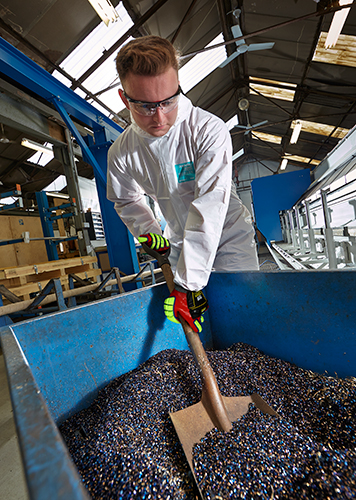The power of real-time monitoring and advanced proper protective gear in the sanitation industry.
By Nick Brown, Senior Director at Ansell Inteliforz
Sanitation workers are some of the most essential members of our communities. Yet for how instrumental their roles are, they’re also some of the riskiest. By leveraging modern tools, we can begin protecting waste and recycling workers to the level they deserve.
Saying that waste and recycling work is risky is an understatement. According to the CDC, the profession ranks as the seventh deadliest in the US. In 2021 alone, of the more than 79,000 sanitation workers in the country, 75% reported some workplace related injury, illness or fatality. For workers that contribute so much to the sustainability and cleanliness of our communities, it’s clear that safety measures could be improved.
In fact, the Environmental Research and Education Foundation has begun researching ways to improve worker safety across the sanitation sector. Given the plethora of modern tools at our disposal, we can drastically reduce workplace injury in waste and recycling.

Sanitation work is demanding on a number of fronts, both obvious and more hidden. First and foremost, handling waste is a major part of the job; one that exposes workers to potential biohazards, chemicals, and much more.
The work is also physically demanding. Sanitation workers are tasked with lifting heavy objects and difficult, repetitive motions. The physicality of the profession can lead to injuries in the short term, but, when coupled with poor ergonomics, can wear down a body over time.
If all of that weren’t enough, sanitation work also exposes workers to the elements. Being outside year-round means performing difficult labor in extreme hot or extreme cold temperatures, oftentimes for long hours with minimal downtime. These environmental factors, particularly when coupled with strenuous exercise can take their toll on workers.
Too often the safety of workers is put at risk simply due to a lack of knowledge or understanding. Sanitation work often involves constant movement in order to reach quotas and finish a route. There isn’t a whole lot of time built in to closely keep track of body movements and safety protocols. This is where real-time monitoring can be a literal lifesaver.
Over the past two decades there have been technological leaps in real-time monitoring through wearables, sensors, cameras and data analytics that can track the movements, vital stats of workers and environmental factors to alert them if something is wrong.
One of the primary benefits of real-time monitoring is its ability to quickly identify and flag to workers the presence of chemical spills or other hazards. For instance, sensors can detect toxic gasses, chemical leaks, or unusual levels of dust and particulates in the air. When such hazards are identified, the system can immediately alert workers through wearable devices, such as smart watches or helmets equipped with visual and auditory signals. This prompt notification allows workers to evacuate the area or take appropriate safety measures, thereby minimizing the risk of exposure to harmful substances.
Additionally, for workers not out in the field, real-time monitoring can track the location of workers and equipment within a facility, ensuring that dangerous zones are clearly marked and avoided. This is particularly important in environments where heavy machinery is in operation, as it helps prevent accidents caused by equipment collisions or improper use.
Beyond detecting environmental hazards, real-time monitoring systems can also play a crucial role in assessing and improving workers’ movements, fatigue levels, and risk of overheating.
Ergonomic injuries, such as musculoskeletal disorders, are common among waste and recycling workers due to repetitive motions and heavy lifting. By using wearable sensors, real-time monitoring systems can analyze workers’ movements and postures, identifying patterns that may lead to strain or injury. When poor ergonomic practices are detected, the system can provide immediate feedback, encouraging workers to adjust their techniques and reduce the risk of injury. This information can also be transmitted to leadership as an impetus for further training or retraining in safe movements – or to explore process re-engineering and ways of reducing or eliminating the risk of long-term injuries forming.
Fatigue is another significant concern in the sanitation industry, as tired workers are more prone to accidents and errors. Real-time monitoring can track indicators such as increased heart rate variability or erratic movement patterns common to fatigue. When these signs of fatigue are detected, the system can alert supervisors, who can then implement rest breaks or reassign tasks to prevent overexertion.
Overheating is a critical issue, especially for workers operating in hot environments or wearing heavy protective gear. Wearable sensors can continuously monitor body temperature and hydration levels, alerting workers and supervisors if a worker is at risk of heat stress. This enables timely interventions, such as providing water or moving the worker to a cooler area, thereby preventing heat-related illnesses.
While real-time monitoring systems significantly enhance safety, they must be complemented by appropriate protective gear. Identifying and using the right gear is crucial for safeguarding essential sanitation workers against the multitude of hazards they face at facilities or in the field.
Personal protective equipment (PPE) should be selected based on the specific risks present in the work environment. For chemical exposure, workers may need chemical-resistant gloves, aprons, and face shields. Respirators or masks are essential for protecting against inhalation of toxic substances or dust. High-visibility clothing is important in environments with heavy machinery to ensure that workers are easily seen by equipment operators.
Ergonomically designed gear, such as supportive footwear and back braces, can help prevent musculoskeletal injuries. Additionally, using tools and equipment that reduce the need for manual lifting and carrying can mitigate the strain on workers’ bodies.
For protection against overheating, lightweight, breathable clothing and cooling vests can be effective. It is also important to provide shaded rest areas and ample hydration stations, particularly in hot climates.
As wearables, tech tools and other PPE have advanced, we’ve arrived at a place where the risk levels for waste and recycling workers shouldn’t be as high as it is. Implementing these enhanced safety measures can reduce the hazards of this essential work by offering data-driven insights to improve safety protocols and training as well as enable early intervention. We owe it to our sanitation workers to get serious about their safety.

Nick Brown is the Head of Ansell Services, a key division of Ansell Healthcare, a 130-year-old global leader in safety solutions. In his role, Nick oversees all value-added services, including the company’s innovative IoT & Safety Tech solutions under the Inteliforz® brand – as well as the company’s proprietary workplace safety & productivity assessment platform, AnsellGUARDIAN ™. Based in New Jersey, USA, Nick has extensive experience leading large sales and marketing teams in the Industrial and Healthcare safety/PPE markets. He has also directed Global Sales Enablement and Customer Experience departments, as well as driven Digital Transformation initiatives.
Nick began his career at Coca-Cola in Australia, where he gained valuable sales and commercial management experience that he brings to his current role. His career has spanned two decades and across four continents, with professional stints in Sydney, Dubai, London, and now New Jersey. He holds a BA from the University of Sydney, Australia.
Outside of work, Nick is a cooking enthusiast and an avid sportsman. He enjoys playing hockey and golf. Additionally, he is a dedicated runner, having completed several marathons, including the New York Marathon and an off-road endurance marathon in the UK. Nick is also a family man, the father of two young girls and a dog, and has been happily married to his wife Joanna for 11 years.
In this episode, I sat down with Beejan Giga, Director | Partner and Caleb Emerson, Senior Results Manager at Carpedia International. We discussed the insights behind their recent Industry Today article, “Thinking Three Moves Ahead” and together we explored how manufacturers can plan more strategically, align with their suppliers, and build the operational discipline needed to support intentional, sustainable growth. It was a conversation packed with practical perspectives on navigating a fast-changing industry landscape.